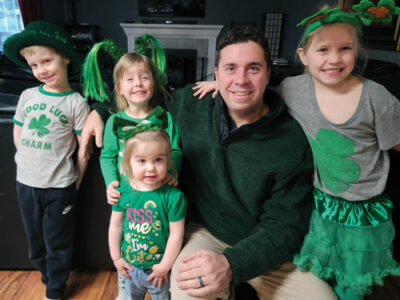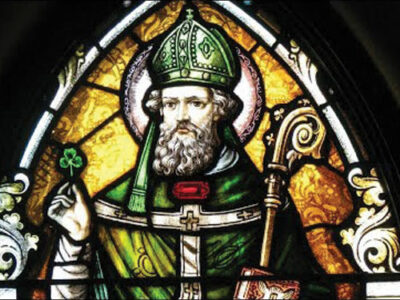
Why St. Patrick’s Day?
I was genuinely curious about the life of St. Patrick and how he became such a well-recognized figure in both modern society and in the church.
It’s fascinating how we celebrate his feast day as well, which led me to wonder, why do so many people religiously (pun intended) take the day off work, wear green and drink green beer?
And why do we ask for everyone to kiss us (we’re Irish🍀) – while kids building leprechaun traps and looking for gold?
Who was St. Patrick?

St. Patrick lived during the 5th century and was born in Britain in a Romanized family. When he was only 16, he was kidnapped by a group of Irish raiders and brought into slavery in Ireland. St. Patrick found his faith while being held prisoner for six years.
At the time, the Irish people were a pagan society that worshiped false gods and animals. He was worked hard as a shepherd and often turned to religion for solace, becoming a devout Christian.
In his memoir, The Confession, he wrote:
“The love of God and his fear grew in me more and more, as did the faith, and my soul was rosed, so that, in a single day, I have said as many as a hundred prayers and in the night, nearly the same. I prayed in the woods and on the mountain, even before dawn. I felt no hurt from the snow or ice or rain.”
St. Patrick
One night, in a dream, he heard the voice of God tell him that his ship was ready, and it was time to leave Ireland. After six years of captivity, he escaped and returned to Britain.
While in Britain, he began training as a priest and during this time, he was visited by angels who called him to return to Ireland and convert the pagans there to Christianity. He followed his calling and during this time, he made it his mission to help educate and convert the Irish people. St. Patrick taught them that there is only one God.
To help the people understand the concept of the Holy trinity, where the Father, Son and Holy Spirit are one, he used the analogy of the 3 leaves on the clover.
St Patrick later became a Catholic Bishop. He is believed to have died on March 17th and that is the day that he is commemorated.
I find it interesting that he wasn’t Irish yet became the patron saint of the entire people of Ireland. He also was never actually officially canonized as a saint by a Pope. He is recognized as St. Patrick today, and this absence of formality wasn’t a snub, but likely due to the nature of the era he lived in.
How we celebrate St. Patrick’s Day

For several centuries, March 17th was a day of solemnity whereas Catholics would attend church in the morning, and then celebrate in the afternoon & evening. There were no parades or green clothes – especially because BLUE (not GREEN) was the color originally associated with Ireland’s patron saint! The earliest images depict St Patrick robed in blue garments. When King George III needed a color to represent the Order of St. Patrick for Ireland, he created “St. Patrick’s Blue”.
When celebrating St. Patrick’s Day, “the wearing of the green” meant to wear a shamrock to display your faith. It is widely believed that in the mid 1700’s, this was misinterpreted to mean “wear green garments”.
Most associate corned beef and cabbage with St. Patrick and Ireland, but this was also an American innovation. While ham and cabbage were eaten in Ireland, corned beef was a cheaper substitute for the poor Irish immigrants living in America.
Interestingly, the first St. Patrick’s Day parade took place in America (in St. Augustine, FL), not Ireland. In Ireland, St. Patrick’s Day has traditionally been a spiritual and religious occasion. Up until the 1970s, Irish laws mandated that pubs be closed on March 17th. It wasn’t until 1995 when the Irish government began a campaign to use interest in St. Patrick’s Day to drive tourism & showcase Irish culture to the world.
Every March 17th, Americans wear green clothes and drink green beer – some rivers are even dyed green. From coast to coast, Jameson flows like water while crowds toast pints of Guinness and shoot Irish Car Bomb shots. These traditions weren’t imported from Ireland, they were “born in America” as March 17th turned into a party day for all ethnicities.
This year, when you are celebrating St Patrick’s Day, remember the courage it took for him to return to Ireland, a land where he was captive for 6 years. Remember the resilience he had in the face of a culture of people who did not believe in one God but worshiped many or none. Also, remember, St. Patrick never drank a green beer – and if you really want to celebrate in his name, have yours dyed blue.
Be well & God bless.







Leave a Reply